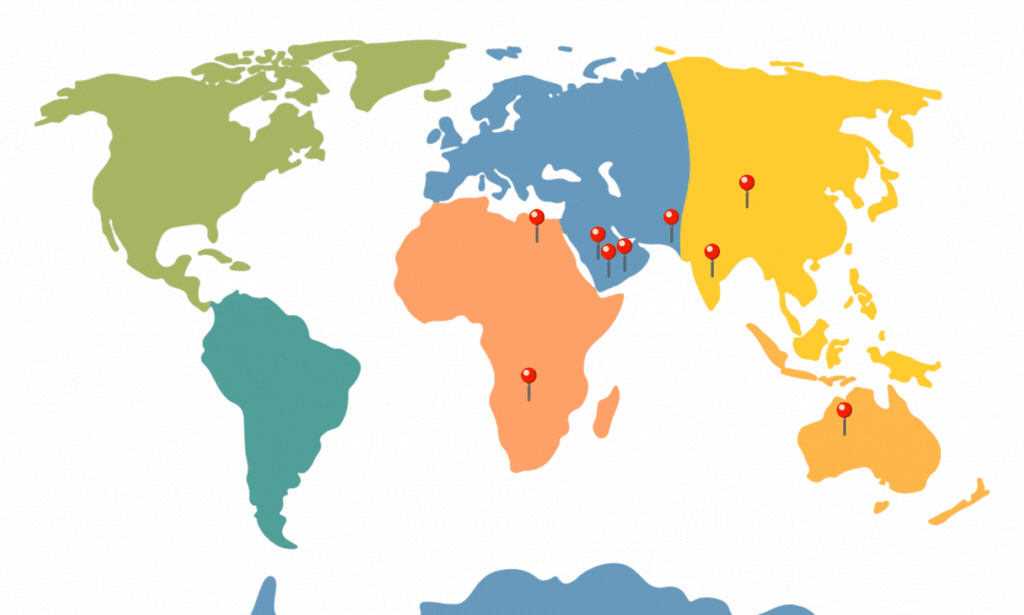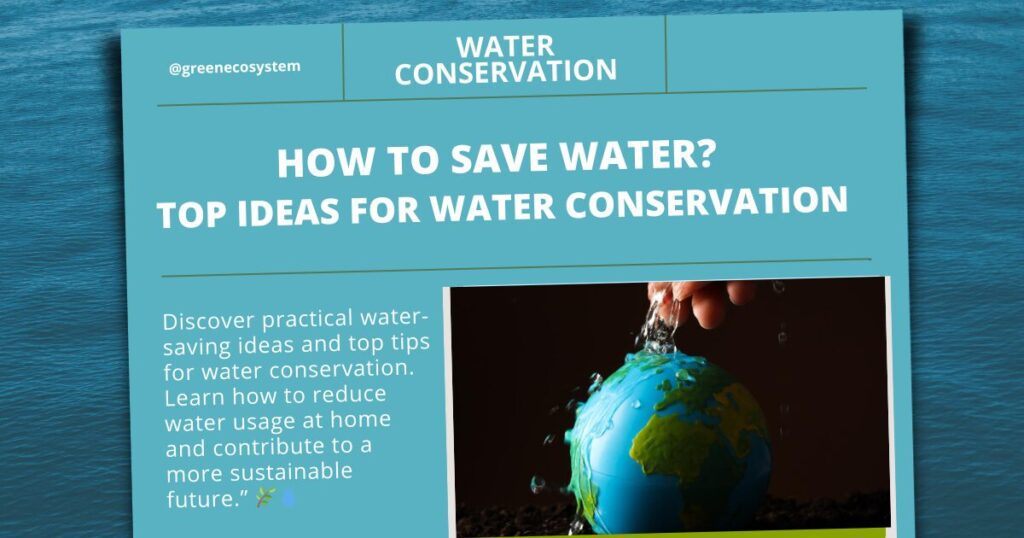Introduction
Water conservation is becoming increasingly crucial day by day for humans, as our planet faces water scarcity challenges. With a diminishing number of freshwater supplies, it’s important that we should start adopting water-saving habits both indoors and outdoors. By implementing simple yet effective strategies, we can significantly reduce our water consumption without compromising our lifestyle.
This blog post will bring you a range of top ideas for water conservation that can be easily incorporated into your daily routine. From mindful water use in the bathroom and kitchen to optimizing outdoor water usage, we’ll provide practical tips that will help you save water and protect our precious resources.
Let’s explore how together we can make a difference through water conservation, But before that, we should learn why water conservation is important and required.
Why We Need To Save Water?
Water is essential for life, yet it’s a limited resource. The increasing global population and climate change have put immense pressure on our water supplies. Many countries are facing water scarcity, leading to droughts, agricultural challenges, and conflicts in the past few years.
Here is the data shown below;

By conserving water, we not only protect our environment but also ensure a sustainable future for upcoming generations. Reducing water consumption helps to:
- Preserve ecosystems: Water is vital for aquatic life and overall biodiversity.
- Protect water quality: Overuse can lead to pollution and contamination.
- Reduce energy consumption: Water treatment and distribution require significant energy.
- Mitigate the impacts of drought: By conserving water, we can better prepare for dry periods.
It should be clear that water conservation is not just a choice but a necessity. Let’s explore practical ways to make a difference.
There are generally two types of water conservation we usually talk about;
- Indoor Water Conservation
- Outdoor Water Conservation
- General Water Conservation
Let’s discuss these types in detail.
Indoor Water Conservation | Tips and Ideas
A large amount of the total water used in households comes from indoor use. From morning baths to dinner we use large amounts of water every day. You don’t have to give up comfort to drastically lower your water footprint by making a few easy adjustments.
You just need to follow the simple ways of water conservation as mentioned below;
Fix Leaks
Even small leaks can waste a surprising amount of water over time. Regularly inspect faucets, pipes, and toilets for any signs of leaks. A dripping faucet, for example, can waste gallons of water per day. Addressing these issues promptly can save you money and conserve water.
Install a High-Efficiency Showerhead
Showering is a major water consumer. Upgrading to a high-efficiency showerhead can reduce water flow without compromising your shower experience. These showerheads use less water while maintaining water pressure, helping you conserve water without sacrificing comfort.
Reduce Shower Times
Taking shorter showers is a simple yet effective way to cut down on water usage. Aim for showers that last five minutes or less. You can also install a shower timer to help you stay on track.
Faucet Aerators
Faucet aerators are inexpensive devices that attach to your faucet and mix air with water. This creates a fuller flow while reducing water consumption. Aerators can significantly decrease water usage without affecting water pressure.
Reuse Water
Graywater, or gently used water from sinks, showers, and washing machines, can be reused for various purposes. For example, you can collect shower water to water plants or use it to clean floors. However, it’s essential to check local regulations before reusing graywater.
Turn Off the Water While Shaving or Brushing Teeth
A running faucet wastes a significant amount of water. Turn off the water while brushing your teeth or shaving to conserve water. You can fill a cup with water to rinse your razor or toothbrush.
Wash Only Full Loads
Whether it’s laundry or dishes, wait until you have a full load before running the machine. This helps to conserve both water and energy.
Use the Toilet as a Toilet
Avoid flushing wipes, tissues, or other items that don’t belong in the toilet. These items can clog the plumbing and lead to unnecessary water usage.
Defrost Food in the Fridge
Instead of running water to defrost frozen food, allow it to thaw naturally in the refrigerator. This simple change can save a considerable amount of water.
Install a Water-Saving Toilet Flush System
Modern toilets use significantly less water per flush than older models. Installing a water-saving toilet flush system can reduce water consumption without affecting the toilet’s performance.
Mindful Water Use
Developing mindful water use habits can make a big difference. Be conscious of your water consumption and look for opportunities to reduce waste. For example, turn off the faucet while washing dishes or use a pitcher of water for drinking instead of running the tap.
Use a Dishwasher
Contrary to popular belief, dishwashers often use less water than handwashing dishes. Modern dishwashers are designed to be water-efficient, so using them for full loads can save water.
By incorporating these tips into your daily routine, you can make a significant impact on water conservation.
Outdoor Water Conservation | Tips and Ideas
Outdoor water use can account for a significant portion of a household’s water consumption. You can conserve water while maintaining a healthy landscape by implementing smart watering practices.
Water Your Lawn Efficiently
Proper watering is crucial for a healthy lawn, but overwatering can waste precious water. Water your lawn deeply but less frequently, allowing the soil to dry slightly between watering. Avoid watering during the hottest parts of the day when water evaporates quickly.
Install Moisture Sensors on Sprinkler Systems
Moisture sensors measure soil moisture and automatically adjust your sprinkler system based on the soil’s hydration level. This prevents overwatering and ensures that your lawn receives the optimal amount of water.
Avoid Watering on Windy Days
Watering on windy days can result in water loss through evaporation. Schedule watering for calm days to maximize water efficiency.
Mulch Everything Possible
Mulching helps retain soil moisture, reducing the need for frequent watering. Apply a layer of mulch around plants and trees to help the soil retain moisture and suppress weed growth.
Plant Native Landscaping
Native plants are adapted to local climate conditions and require less water than non-native plants. Incorporating native plants into your landscape can significantly reduce your water consumption.
Repair and Calibrate Your Irrigation System
Regularly inspect your irrigation system for leaks and broken sprinkler heads. Ensure that your sprinklers are watering your lawn and not sidewalks or driveways. Calibrate your system to deliver the appropriate amount of water to your plants.
Replace Your Grass/Turf with Water-Wise Plants
Consider replacing water-intensive grass with drought-tolerant plants, such as succulents, groundcovers, or native grasses. These plants require less water and can create a beautiful landscape.
Use Drip Irrigation
Drip irrigation delivers water directly to the roots of plants, minimizing water loss through evaporation. This method is highly efficient and can save a significant amount of water compared to traditional sprinkler systems.
By adopting these outdoor water conservation practices, you can help preserve our precious water resources while maintaining a vibrant and healthy landscape.
General Water Conservation Tips | Tips and Ideas
Beyond specific indoor and outdoor practices, there are general water conservation principles that can be applied across various settings.
- Check for Leaks Regularly: Even small leaks can waste a significant amount of water. Regularly inspect pipes, faucets, and toilets for any signs of leaks and repair them promptly.
- Use Water-Saving Devices: There are various water-saving devices available in the market, such as low-flow showerheads, faucet aerators, and toilet dams. Incorporating these devices can help reduce water consumption without compromising convenience.
- Educate Others: Spread awareness about water conservation by sharing tips with family, friends, and neighbors. Encourage them to adopt water-saving habits.
- Support Water-Saving Initiatives: Get involved in local water conservation programs and support policies that promote water efficiency.
- Be Mindful of Water Usage: Develop a conscious awareness of your water consumption. Make small changes to your daily routine, such as turning off the faucet while brushing your teeth or taking shorter showers.
By adopting these general water conservation practices, you can contribute to water sustainability and help protect this precious resource for future generations.

